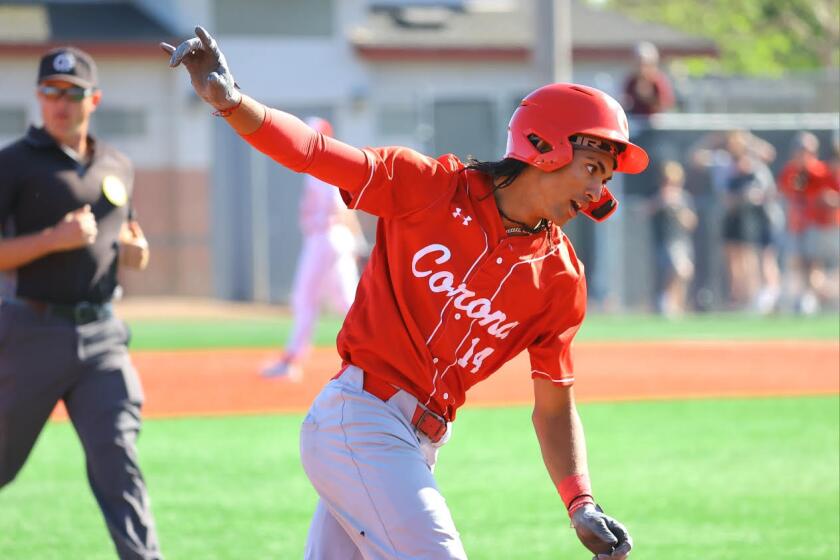Late-Blooming Brown Simply Special Now
- Share via
When the Raiders drafted Tim Brown in the first round in 1988, a lot of people thought they had made a mistake. Brown had several strikes against him: He was a Heisman Trophy winner, he was from Notre Dame and, although he wasn’t slow, neither did he have blazing speed.
Worst of all, he didn’t really have a position.
Contrary to popular belief, a Heisman in the trophy case is no guarantee a pro career will be a cup winner, too. The ranks of guys who looked can’t-miss and missed anyway are legion. For every Roger Staubach who made it big, there is a Joe Bellino who didn’t even make it small. For every O.J. Simpson, there was a Johnny Rodgers. You might get a Jim Plunkett at quarterback, but you might get a Pat Sullivan, too.
Conversely, many a great one went overlooked by the Heisman balloters--John Unitas, Dan Marino, Franco Harris, even Bob Griese. Can you believe the highest Jim Brown rose in the voting was fifth?
Quite apart from the Heisman hoodoo, the Raiders didn’t quite know what to do with Tim. He was a wide receiver but he also returned punts and kickoffs. Stumped, they put him on special teams. In football, special means suicidal.
He caught 43 passes his first season for 725 yards. But he returned kickoffs 1,098 and ran back punts 444.
Tim didn’t much care how he got his hands on the ball, so long as he did. So, he picked up 2,316 yards altogether in his rookie season. But he was a little bit like a star playing the butler.
He was on a team famous for its receivers. Cliff Branch had duped cornerbacks for a decade. So had Fred Biletnikoff, and, for lesser periods, Kenny King and Willie Gault. The fastest guys in uniform ran Raider patterns. Owner Al Davis combed the Olympic start lists for prospects. Gold medalists, state sprint champions, world-class runners were picked by Al.
You see, Davis could never abide that plodding, strong-arm, circle-the-wagons, three-yards-and-a-cloud-of-dust football. His heroes were military men who specialized in quick far-reaching demoralizing strikes.
Al’s teams got touchdowns from all over the place, not merely the one-yard line. Good field position to the Raiders was wherever they had the ball. His plays had the defense in the proverbial position of trying to look over both shoulders at once. He didn’t want to take 10 plays and a penalty to score a touchdown. Al wanted the 10-second TD. The knockout.
His quarterbacks were known as mad bombers, blitzkriegers. His teams didn’t need the ball much. Let the other guys push it up through the mud. Davis’ teams struck like cavalry.
They kept telling him that didn’t work anymore, that football had become trench warfare. Al listened--and went out and signed up some more speed merchants, guys who could run 50 yards as fast as a football could fly through it.
They had some trouble seeing Tim Brown in this scheme. Tim is not going to anchor the Olympic relay team.
They liked his moves--with kickoffs and punts. They were less sold on fly patterns. Brown returned 37 to 49 punts a year. One year, 1991, he started only one game as a wide receiver.
But gradually, one thing began to dawn on the Raider brain trust: When he was in there--usually on third and long--Brown would be as wide open as Dodge City on Saturday night.
But the other half of touchdown-pass receiving is touchdown-pass throwing. For most of his career, Tim had some of the most inconsistent deliverers of the football the league has ever seen. Gone were Lamonica, Stabler, Plunkett and in the irons were guys who would have been better trying to deliver touchdown passes by junk mail.
Still, Brown perfected his craft. He studied defenders the way a pitcher studies hitters, but mostly he studied coverages. He found the soft spots, the open spaces in the opponents’ zones. He exploited them.
In baseball, they say of a player that he never becomes a pitcher till he stops being a thrower. And in football, you never become a receiver till you stop being a mere runner. Olympic speed is nice, but even Jerry Rice has to get open.
Some of the same people who questioned Davis’ bringing Tim Brown to the team--Tim was their first-round pick, but the sixth man taken overall--questioned his bringing Jeff Hostetler in even more vehemently. To their minds, Hostetler was just Phil Simms’ backup, which is about as prestigious as being Mike Tyson’s sparring partner.
But 80 times--a Raider record--Hostetler found Tim Brown open this year. Of the 14 regular-season touchdown passes he threw, seven were to Tim Brown.
In the season finale against Denver, the combination put the Raiders in the Super Bowl hunt when Hostetler completed 11 passes for 173 yards and two touchdowns to Brown.
And, then, in the first playoff game Sunday, Hostetler-to-Brown accounted for a first-quarter, 65-yard touchdown play.
They might not be able to make the world forget Isbell to Hutson, Waterfield to Fears, Van Brocklin to Hirsch, Unitas to Berry, Plunkett to Branch, or Montana to Rice, but Hostetler to Brown is reviving that old-time Raider football that spreads the defenses, gives cornerbacks headaches and safeties high-blood pressure.
And Tim Brown is striking a blow for Heisman winners everywhere, besides reviving “Raider football,” the object of which is to surprise the opponent, not bore him to death.
More to Read
Go beyond the scoreboard
Get the latest on L.A.'s teams in the daily Sports Report newsletter.
You may occasionally receive promotional content from the Los Angeles Times.










